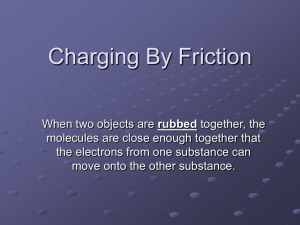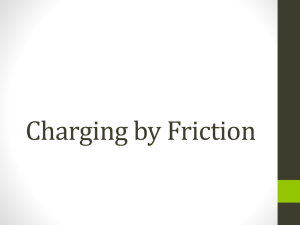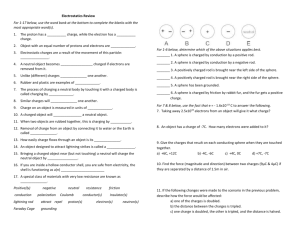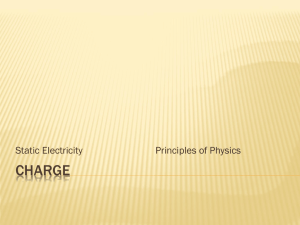Charging by Contact - Science By Caslick
advertisement
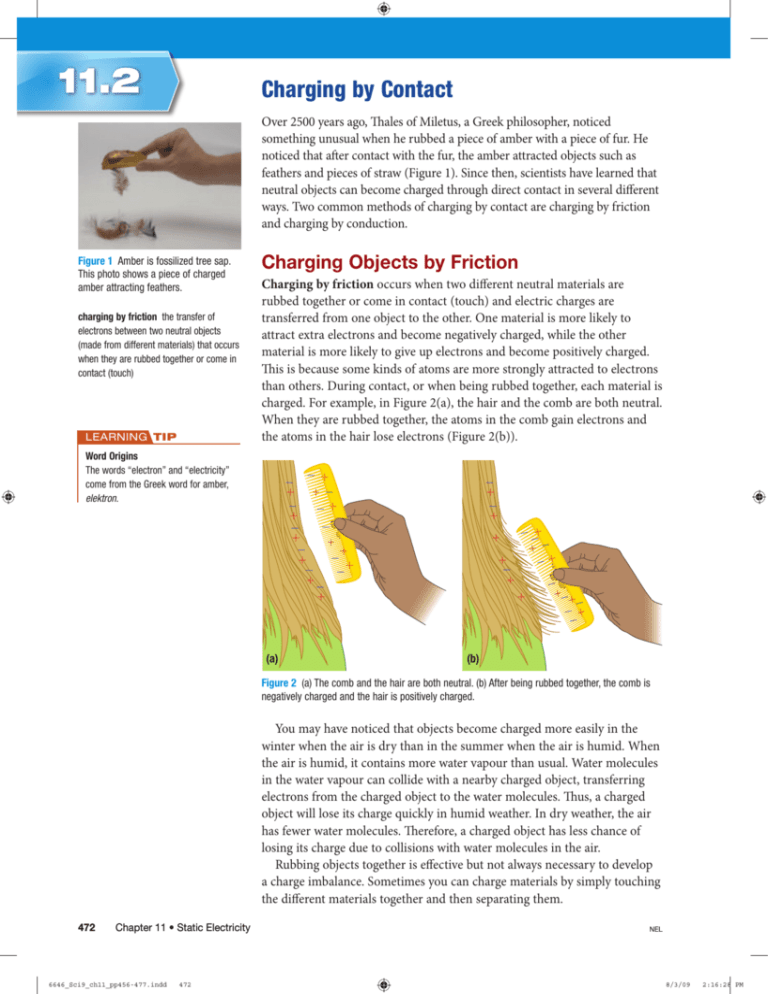
11.2 Charging by Contact Over 2500 years ago, Thales of Miletus, a Greek philosopher, noticed something unusual when he rubbed a piece of amber with a piece of fur. He noticed that after contact with the fur, the amber attracted objects such as feathers and pieces of straw (Figure 1). Since then, scientists have learned that neutral objects can become charged through direct contact in several different ways. Two common methods of charging by contact are charging by friction and charging by conduction. Figure 1 Amber is fossilized tree sap. This photo shows a piece of charged amber attracting feathers. charging by friction the transfer of electrons between two neutral objects (made from different materials) that occurs when they are rubbed together or come in contact (touch) LEARNING TIP Charging Objects by Friction Charging by friction occurs when two different neutral materials are rubbed together or come in contact (touch) and electric charges are transferred from one object to the other. One material is more likely to attract extra electrons and become negatively charged, while the other material is more likely to give up electrons and become positively charged. This is because some kinds of atoms are more strongly attracted to electrons than others. During contact, or when being rubbed together, each material is charged. For example, in Figure 2(a), the hair and the comb are both neutral. When they are rubbed together, the atoms in the comb gain electrons and the atoms in the hair lose electrons (Figure 2(b)). Word Origins The words “electron” and “electricity” come from the Greek word for amber, elektron. (a) (b) Figure 2 (a) The comb and the hair are both neutral. (b) After being rubbed together, the comb is negatively charged and the hair is positively charged. You may have noticed that objects become charged more easily in the winter when the air is dry than in the summer when the air is humid. When the air is humid, it contains more water vapour than usual. Water molecules in the water vapour can collide with a nearby charged object, transferring electrons from the charged object to the water molecules. Thus, a charged object will lose its charge quickly in humid weather. In dry weather, the air has fewer water molecules. Therefore, a charged object has less chance of losing its charge due to collisions with water molecules in the air. Rubbing objects together is effective but not always necessary to develop Ontario Science 9 SB a charge imbalance. Sometimes you can charge materials by simply touching 0-17-635529-7 the different materials together and then separating them. 472 C11-F10ab-UDOS9SB FN Chapter 11CO • Static Electricity Allan Moon Revised Final Pass Approved Not472 Approved 6646_Sci9_ch11_pp456-477.indd NEL 8/3/09 2:16:28 PM The Electrostatic Series The electrostatic series, or triboelectric series, is a list of materials in order of increasing tendency to gain electrons (Table 1). As you move further down the list, the materials increase in their tendency to gain extra electrons. We can use the electrostatic series to predict the charge that will be gained by two objects or materials that are rubbed together. For example, if two materials from the series are rubbed together, the material that is higher on the series will lose electrons and become positively charged and the material that is lower on the series will gain electrons and become negatively charged. SAMPLE PROBLEM 1 Using the Electrostatic Series You rub a piece of wool against your skin. What charge does each material now have? Step 1 Compare the positions of the materials on the electrostatic series. Wool is lower on the list than human skin. Step 2 Compare the attraction for electrons of the two materials. Since wool is lower on the list than human skin, it has a greater attraction for electrons than human skin. The wool will gain electrons from your skin and become negatively charged. Your skin will lose electrons to the wool and become positively charged. Practice You grab a rubber balloon with a wool glove on your hand. What charge does each material now have? T RY THIS electrostatic series a list of materials arranged in order of their tendency to gain electrons Table 1 Electrostatic Series Material Charge tendency human skin rabbit fur acetate glass human hair nylon wool cat fur silk paper cotton wood amber rubber balloon vinyl polyester ebonite (weaker tendency to gain electrons) (stronger tendency to gain electrons) CHARGING BY FRICTION SKILLS: Performing, Observing, Analyzing, Communicating Materials do not always need to be rubbed together to create a charge imbalance. In this activity, you will explore charging by friction through simple contact. Equipment and Materials: roll of clear, plastic adhesive tape 1. Pull two 8–10 cm pieces of tape from the roll. 2. Hold one piece of tape in each hand and bring the two shiny (non-sticky) sides of the tape close together without letting them touch (Figure 3). Record your observations. SKILLS HANDBOOK 3.B.5., 3.B.6. 4. Using the same two pieces of tape, allow each piece of tape to stick to the top of a clean desk without rubbing. Then quickly pull the pieces off the desk. Bring the shiny, non-sticky side of one of the pieces close to the edge of the desk without letting it touch the desk. Observe what happens. 5. Quickly bring the shiny, non-sticky sides of both pieces of tape close to each other without letting them touch. Observe what happens. A. What do your observations in step 2 indicate about the electric charge on the pieces of tape when they were first pulled off the roll? Explain. T/I C B. What do your observations in step 3 indicate about the electric charge on the pieces of tape? Explain. T/I C. Why is there a difference in the electric charge on the pieces of tape between steps 2 and 3? T/I Figure 3 3. Exhale onto both sides of each piece of tape several times (over its entire length). Bring the two shiny sides of the tape close together again without letting them touch. Observe what happens. 11.2 Charging by Contact NEL 6646_Sci9_ch11_pp456-477.indd D. Write a question you have about the observations you made in this activity. Exchange questions with a classmate and decide how you may find answers to your questions. Then design and carry out simple experiments to answer your questions. T/I 473 473 8/3/09 2:16:34 PM Charging Objects by Conduction charging by conduction charging an object by contact with a charged object In addition to charging by friction, objects can also be charged by conduction. Charging by conduction occurs when two objects with different amounts of electric charge come in contact and electrons move from one object to the other. This is illustrated in Figure 4, which shows a negatively charged bar touching a neutral sphere. As a result of the contact, some of the excess electrons on the charged bar which are repelling each other, move onto the sphere. As a result, the sphere becomes negatively charged. – – – + –+ – – – – + – + +–+ – – – + –+ – – – – (a) – + – + +–+ – (b) Figure 4 A neutral metal sphere (a) becomes charged by conduction when brought in contact with a negatively charged bar. Some of the electrons are transferred from the bar to the sphere, resulting in an overall negative charge on the sphere (b). WRITING TIP Identify the Topic Use the first paragraph to identify the topic and state your main idea/ opinion concisely. For example, “Can an object be charged by conduction?” Yes—when two charged objects come in contact electrons may move from one object to the other. After contact, the two objects will have the same type and amount of charge. Ontario Science 9 SB 0-17-635519-7 C11-F12a-UDOS9SB FN CrowleArt Group CO Deborah Crowle 4th pass Pass Approved Not Approved Charging by conduction, however, does not always involve a charged object and a neutral object. Two charged objects may come in contact, and C11-F12a-UDOS9SB.ai electrons may move from one object to the other. Electrons always move from the object with a larger negative charge (less C11-F12b-UDOS9SB.ai positive) to the object with the smaller negative charge (more positive). This produces a more even distribution of electric charge between the two objects. For example, if a positively charged piece of metal comes in contact with another identically sized piece of metal that has less positive charge (Figure 5(a)), electrons will travel from the less positively charged piece to the more positively charged piece until both pieces have an even distribution of charge (Figure 5(b)). Ontario Science SB pieces of metal each still have a positive charge Aft er contact, the9 two (Figure 5(c)). The electric charge is not neutralized in the two pieces of 0-17-635519-7 metal after they come in contact, but they both now have the same type and C11-F12b-UDOS9SB FN amount of charge.CrowleArt Group CO Deborah Crowle + + – + 4th pass + – + – + Pass – + – + + – + Approved metal rod X metal rod Y Not Approved (overall 3 charge) (overall 1 charge) (a) + metal rod X (gaining an electron) + – + – + + – + + – + – + + – + metal rod Y (overall 2 charge) (c) Figure 5 Two metal rods being charged by conduction C11-F13a-UDOS9SB.ai C11-F13b-UDOS9SB.ai Chapter 11 • Static Electricity 6646_Sci9_ch11_pp456-477.indd 474 metal rod Y (losing an electron) (b) metal rod X (overall 2 charge) 474 + – + + – + – + – + – + + – + NEL C11-F13c-UDOS9SB.ai 8/3/09 2:16:35 PM Grounding Objects with an excess electric charge—either positive or negative—can have the excess charge removed by a process called grounding. Grounding an object involves removing the excess charge by transferring electrons between the object and a large neutral object such as Earth (the ground). Any object that serves as a seemingly infinite reservoir of electrons can be used as a “ground” for electric charges. For example, because Earth is so large, any excess charge is spread over a huge area and is effectively neutralized. When a positively charged object is grounded, electrons from the ground travel up to the positively charged object until the object is neutral. When a negatively charged object is grounded, electrons travel from the object into the ground until the object is neutral. Figure 6 shows the symbol for grounding. What happens during the grounding of a charged object or person? Figure 7 shows what happens when a student carrying a negative charge on his hand comes in contact with a neutral faucet that is grounded. If the student reaches for the faucet with his hand, he will receive a shock as the excess electrons are transferred from his hand to the faucet. After grounding, the hand loses the negative charge and is neutral. The charge imbalance between the hand and the faucet is gone. (a) (b) Figure 6 The symbol for grounding grounding connecting an object to a large body, like Earth, that is capable of effectively removing an electric charge that the object might have (c) Figure 7 (a) Before the discharge, the hand is negatively charged and the faucet is neutral. (b) During the discharge, excess electrons are transferred from the hand into the ground. (c) After the discharge, the negative charge on the hand has been removed. Putting Charged Objects to Work Advances in electrostatics have led to the development of many useful products and technologies. Several of these involve charging objects by contact (friction or conduction). Electrostatic Dusters Electrostatic dusters depend on charging by friction to attract dust. When you use an electrostatic duster, you gently sweep it across an object, causing a buildup of charge on the duster. The dust is attracted to the electrostatic duster and “jumps” off the dusty Ontario 9 SB surfaceScience onto the duster. Natural electrostatic dusters 0-17-635529-7 have been used since the 1800s. Ostrich feathers, C11-F17abc-UDOS9SB FNlike human hair, have a natural tendency to become Allan Moon CO charged when rubbed against a surface (Figure 8). 2nd Pass This causes dust to pass be attracted to the feathers. Approved Not NEL Approved 6646_Sci9_ch11_pp456-477.indd Figure 8 Charged ostrich feather dusters keep dust trapped on the feathers. 11.2 Charging by Contact 475 475 8/3/09 2:16:39 PM RESEARCH THIS FABRIC SOFTENER SHEETS SKILLS: Analyzing the Issue, Communicating, Evaluating Many people use fabric softener dryer sheets to control static charge buildup on clothes. As clothes made of different materials tumble inside a clothes dryer, they rub together and become charged by friction. Fabric softener sheets prevent the buildup of static charges. 1. Research how fabric softener sheets prevent the buildup of static charges. 2. Research what chemicals are used in fabric softener sheets and their effects on people and the environment. SKILLS HANDBOOK 4.A. A. Analyze how this technology works to hinder the effect of charging by friction. Draw a diagram to support your analysis. T/I C B. List some benefits and drawbacks of using fabric softener sheets. Suggest alternatives to using fabric softener sheets. A C. Based on your research, decide whether fabric softener sheets are necessary. Support your opinion. T/I A GO TO NELSON SCIENCE WRITING TIP Electrostatic Precipitators Use Evidence To support the main idea or opinion, use facts, statistics, examples, or reasons. For example, in a persuasive essay about electrostatic precipitators (ESPs) for household use, you might give statistics to show that ESP filters are the best and cheapest way of cleaning the air from forced-air furnaces. Almost half of the world’s electrical energy is generated by burning coal, oil, and natural gas. These processes release small particles of soot, dust, and other substances that can pose health risks and cause environmental damage. These particles are expelled from large chimneystacks into the air. An electrostatic precipitator is a device that uses the properties of electrostatic charge to remove particles from the air. Electrostatic precipitators are used in large power plants, manufacturing plants, and incinerators. Figure 9 shows how an electrostatic precipitator can be used to filter particles from smokestack emissions. When smoke passes through the negatively charged plates, the particles in the smoke become negatively charged by conduction. The particles then pass between positively charged plates, which they stick to, due to the attraction of opposite charges. The particles fall onto the collection plate, allowing them to be safely removed. Electrostatic precipitators use very little electricity and are very good filtration devices. About 99 % of the particles in smokestack emissions can be removed by an electrostatic precipitator. Many household air purifiers also use electrostatic precipitators to clean the air. exhaust without ash and dust particles positively charged plate negatively charged particles collection plate negatively charged plates ash and dust particles emissions containing ash and dust particles Figure 9 Electrostatic precipitators use charged plates to filter the particles out of flowing gases such as exhaust and household air. 476 Chapter 11 • Static Electricity NEL exhaust without ash and dust particles 6646_Sci9_ch11_pp456-477.indd 476 8/3/09 2:16:43 PM IN SUMMARY • Charging by friction occurs when two neutral objects made of different materials rub against or touch each other and electrons are transferred between them. • Charging by conduction occurs when two objects with different amounts of electric charge come in contact and electrons are transferred from one object to the other. • When objects are charged by friction, one material is more likely to accept electrons, while the other is more likely to give up electrons. This is because some kinds of atoms are more strongly attracted to electrons than others. • A neutral object is charged by conduction when a charged object touches it. The neutral object becomes charged with the same charge as the object that touched it. • The electrostatic series is a list that ranks the tendency of different materials to gain electrons. It can be used to predict the charge that will be gained by two objects (made from different materials) when they come in contact. • When two charged objects with different amounts of electric charge come in contact, electrons are transferred between them. • When we ground an object, we transfer electrons between the object and a large neutral object such as Earth (the ground). • Charging objects by friction or by conduction has practical applications. CHECK YOUR LEARNING 1. Consider the following pairs of materials. Using the electrostatic series, determine the charge that each material will gain when the two are rubbed together. K/U (a) glass and silk (b) ebonite and fur (c) human hair and a rubber balloon (d) amber and cotton 2. Why do objects made from different materials develop an electric charge when rubbed together? What is this method of charging called? Use a diagram to illustrate your answer. K/U C 3. In your own words, explain charging by conduction. Include diagrams showing how a positively charged object can be used to charge a neutral object. K/U C 5. A rod, “X,” has a positive charge of 8. An otherwise identical rod, “Y,” has a negative charge of 4. The rods are touched together and then separated. (a) When they touched, what particles moved between them? K/U (b) Did the particles move from “X” to “Y” or from “Y” to “X”? K/U 6. Describe how electrons travel when a positively charged object is grounded. K/U 7. Why do you think that some factories might not use electrostatic precipitators? A 8. Describe a situation in which static electricity was a nuisance for you. How did the objects involved become charged? A 4. Use a graphic organizer to compare charging by conduction to charging by friction. K/U C 11.2 Charging by Contact NEL 6646_Sci9_ch11_pp456-477.indd 477 477 8/3/09 2:16:43 PM
